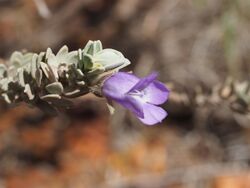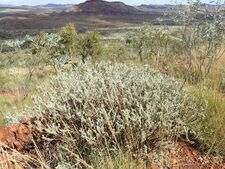Biology:Eremophila jucunda subsp. pulcherrima
| Eremophila jucunda subsp. pulcherrima | |
|---|---|

| |
| E. jucunda pulcherrima leaves and flower | |
| Scientific classification | |
| Kingdom: | Plantae |
| Clade: | Tracheophytes |
| Clade: | Angiosperms |
| Clade: | Eudicots |
| Clade: | Asterids |
| Order: | Lamiales |
| Family: | Scrophulariaceae |
| Genus: | Eremophila |
| Species: | |
| Subspecies: | E. j. subsp. pulcherrima
|
| Trinomial name | |
| Eremophila jucunda subsp. pulcherrima Chinnock[1]
| |
Eremophila jucunda subsp. pulcherrima is a plant in the figwort family, Scrophulariaceae and is endemic to Western Australia. It is a small shrub with grey, hairy leaves and sepals and blue or mauve flowers often growing in stony places. It is similar to subspecies jucunda but is distinguished from it by its grey new growth and more northerly distribution.
Description
Eremophila jucunda subsp. pulcherrima is a shrub which usually grows to a height of 0.2–1 metre (0.7–3 ft). Its branches and leaves are hairy and the leaves are densely arranged near the ends of branches, lance-shaped to egg-shaped, 8–20 millimetres (0.3–0.8 in) long and 2–6 millimetres (0.08–0.2 in) wide. The young leaves and branches are grey-coloured.[2][3]
The flowers are lilac-coloured to purple and occur singly in the leaf axils on flower stalks 3–9 millimetres (0.1–0.4 in) long. There are 5 sepals which are linear to lance-shaped, 9–17 millimetres (0.4–0.7 in) long and 1–3 millimetres (0.04–0.1 in) wide. The 5 petals form a tube 17–29 millimetres (0.7–1 in) which is glabrous on the outer surface. Flowering usually occurs in September and is followed by fruit which are oval to cone-shaped and 5–9 millimetres (0.2–0.4 in) long.[2][3]
Taxonomy and naming
Eremophila jucunda subsp. pulcherrima was first described by Robert Chinnock in 2007.[1] The epithet pulcherrima is a Latin word meaning "prettiest".[4]
Distribution and habitat
This eremophila grows on rocky hils or on clay flats between Paraburdoo and Newman.[5][6]
Conservation
Eremophila jucunda subspecies pulcherrima is classified as "not threatened" by the Western Australian Government Department of Parks and Wildlife.[5]
References
- ↑ 1.0 1.1 "Eremophila jucunda subsp. pulcherrima". APNI. https://id.biodiversity.org.au/instance/apni/619455. Retrieved 4 September 2016.
- ↑ 2.0 2.1 Chinnock, R.J. (Bob) (2007). Eremophila and allied genera: a monograph of the plant family Myoporaceae (1st ed.). Dural, NSW: Rosenberg. pp. 517–518. ISBN 9781877058165.
- ↑ 3.0 3.1 Brown, Andrew; Buirchell, Bevan (2011). A field guide to the eremophilas of Western Australia (1st ed.). Hamilton Hill, W.A.: Simon Nevill Publications. p. 155. ISBN 9780980348156.
- ↑ Brown, Roland Wilbur (1956). The Composition of Scientific Words. Washington, D.C.: Smithsonian Institution Press. p. 132.
- ↑ 5.0 5.1 "Eremophila jucunda subsp. pulcherrima". FloraBase. Western Australian Government Department of Parks and Wildlife. https://florabase.dpaw.wa.gov.au/browse/profile/17519.
- ↑ Paczkowska, Grazyna; Chapman, Alex R. (2000). The Western Australian flora: a descriptive catalogue. Perth: Wildflower Society of Western Australia. p. 337. ISBN 978-0646402437.
Wikidata ☰ Q28184268 entry
 |


